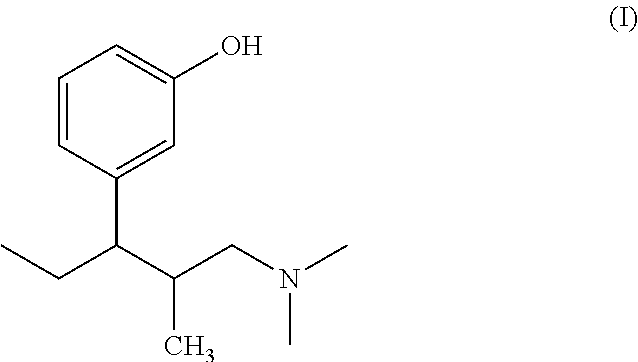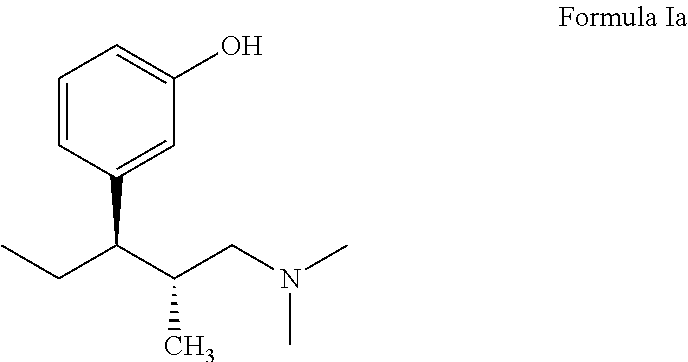Process for preparing L-phenyl-3-dimethylaminopropane derivative
a technology of phenyl-3dimethylaminopropane and process, which is applied in the preparation of organic compounds, amino-hyroxy compounds, organic chemistry, etc., can solve the problems of chiral hplc, which is not amenable to industrial level synthesis, and achieves the effect of improving the stability and stability of the chiral hpl
- Summary
- Abstract
- Description
- Claims
- Application Information
AI Technical Summary
Benefits of technology
Problems solved by technology
Method used
Image
Examples
example 1
Preparation of Toluene-4-sulfonic Acid 3-propionyl-phenyl Ester
[0141]To a stirred suspension of 1-(3-hydroxy-phenyl)-propan-1-one (200 g, 1.33 mol) and potassium carbonate (368 g, 2.66 mol) in dichloromethane (2 L), p-toluenesulfonyl chloride (279.62 g, 1.46 mol) was added at 0° C. and stirred at 30-35° C. for 1 hour. Reaction mixture was diluted with dichloromethane (1 L) and washed with water (2×1 L). Organic layer was separated and dried.
[0142]Solvent were distilled off to give 405 g of the title compound.
[0143]By using the similar method, 85 g of the toluene-4-sulfonic acid 3-propionyl-phenyl ester was prepared from 50 g of 1-(3-hydroxy-phenyl)-propan-1-one by replacing potassium carbonate with sodium hydroxide and replacing dichloromethane with toluene.
[0144]1H NMR δ (CDCl3): 7.19-7.85 (m, 8H, ArH), 2.9 (2H, q, CH2CH3), 2.45 (3H, s, ArCH3), 1.17 (3H, t, CH2CH3)
example 2
Preparation of Toluene-4-sulfonic Acid 3-propionyl-phenyl Ester
[0145]To a stirred suspension of 1-(3-hydroxy-phenyl)-propan-1-one (2 kg, 13.32 mol) and potassium carbonate (3.681 kg, 26.64 mol) in dichloromethane (20 L), p-toluenesulfonyl chloride (2.8 kg, 14.65 mol) was added at 30-35° C. The reaction mixture was stirred at 30-35° C. for 1 hour. Reaction mixture was diluted with dichloromethane (10 L) and washed with water (2×10 L). Dichloromethane layer separated, dried and solvent distilled off to give title compound. Cyclohexane (10 L) was added to the resulting product at 65-70° C. and stirred for 2 hours. Mixture was cooled to ambient temperature, filtered and dried to give 3.87 kg the title compound.
[0146]Product displays the 1H-NMR spectrum similar to product of example 1.
example 3
Preparation of [2RS]-3-dimethylamino-1-(3-hydroxy-phenyl)-2-methyl-propan-1-one
[0147]A mixture of 1-(3-hydroxy-phenyl)-propan-1-one (5 g, 0.03 mol), paraformaldehyde (1 g, 0.03 mol), dimethylamine hydrochloride (3 g, 0.04 mol), hydrochloric acid (3.4 ml, 30%) and isopropanol (15 ml) was refluxed for 16 hours. Isopropanol was distilled off from the reaction mixture and resulting reaction mass was cooled to 25-30° C. Water (15 ml) was added to the reaction mass and washed with isopropyl ether (2×15 ml). Layers were separated and aqueous layer was added to a stirred mixture of aqueous sodium hydroxide solution (1.2 g in 16 ml water) and methyl tert-butyl ether (25 ml). Layers were separated. Organic layer was washed with water (10 ml), dried and solvent was distilled to give 3.45 g of the title compound.
PUM
 Login to View More
Login to View More Abstract
Description
Claims
Application Information
 Login to View More
Login to View More - R&D
- Intellectual Property
- Life Sciences
- Materials
- Tech Scout
- Unparalleled Data Quality
- Higher Quality Content
- 60% Fewer Hallucinations
Browse by: Latest US Patents, China's latest patents, Technical Efficacy Thesaurus, Application Domain, Technology Topic, Popular Technical Reports.
© 2025 PatSnap. All rights reserved.Legal|Privacy policy|Modern Slavery Act Transparency Statement|Sitemap|About US| Contact US: help@patsnap.com



